Apogee Duetta Signature – Graz KLM5 MRTW ribbons with new interfaces and wired returns
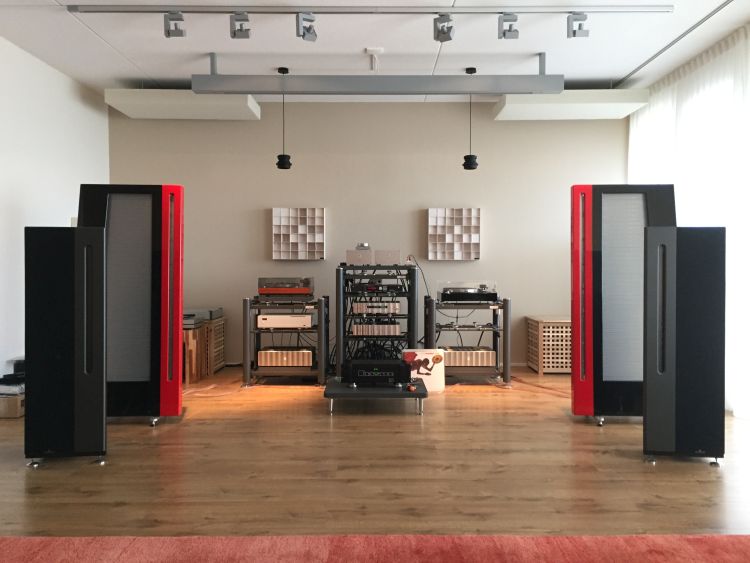
Installing Graz’s latest KLM5 MRTW ribbons with new interfaces and wired returns
This is a follow-up review of the initial Duetta Signature review.
When one of the Duetta Signatures’ channels started sounding less energetic and darker than the other, and no amount of crossover-, cable- or component swapping could fix this, I sought advice from Graz.
After explaining my experiences with the original and refurbished Duettas, he suggested I install new MRTW ribbons, not only because the KLM5’s are hugely improved over the older KLM2’s, but also to rule out any damage that may have occurred to the older ribbons due to stress from playing too loudly. Graz said that in addition to the ribbons having new interfaces (the way they connect to the frame), he had also devised a new wired return, which replaces the extra lengths of aluminum inside the speaker with a special formula wire.
More info about the new Interfaces and Wired Returns
The main effect of this circuit design is to lock the circuit in at its predicted best-case measurements. When the original ribbons were made, there was often a considerable variation in the backed ribbons (0.4 – 0.5 ohms window). Further, the original foil returns are prone to oxidization and gradual degradation. This does not happen with the new system.
With the new ribbons and the return circuit, the typical window decreases to better than 0.1 of an ohm from reference. The benefits far outweigh several times the expenditure in any other area of a hi-fi system, including crossover parts. Given the vast benefits, Graz confidently states that he would not restore a speaker today without this modification.
All new wired circuit returns from 2013 onwards are upgraded to a gold-plated interface.
Main benefits:
- Kakes the measured parameters accurate to typically <0.03 of an ohm
- Increases ribbon life and stability
- Allows for easier future MRTW ribbon replacements without the stress of the original circuit system, as it is much more user-friendly for subsequent replacements
- Decreases electrical degradation and seems humidity-independent
- Decreases the chance of ribbon fractures at the clamps
In addition to the new method, the upgraded foil returns will remain available for those who like the old-fashioned way of doing things.
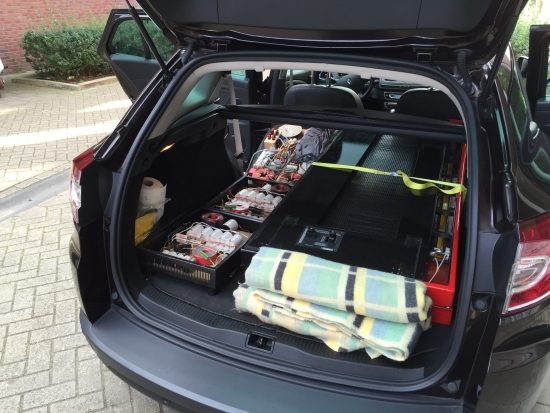
Ready for a ride to the Doctor v.d. Hoeven surgery clinic: Duettas (this review) and Diva crossovers (another story).
Preparing for Surgery
Although these are technically still Jan Willem’s speakers because he purchased them, they have been in my possession for almost 4 years. Still, so far, there has been no intent to bring them over to his apartment because he is so happy with how the original Duetta Sigs work in his system, and the refurbished set’s relatively harsher and more forward sound have not convinced him. So, JW was more than happy to let his refurbed babies go to the H.v.d Hoeven clinic for a beauty treatment. All this time the speakers had had no mesh to protect the drivers and it really is a miracle that I have not once accidentally damaged the foils during one of the very many listening sessions and cable comparisons. So, it seemed prudent to have Henk install the mesh while the speakers were in surgery anyway. To top things off, Henk would measure the bass panels’ resonances and adjust tension if required. As it turned out, the bass panels were still close to optimal and required only subtle optimizing.
Initial Listening
Graz already warned me that the speakers would need at least 80 hours of normal music replay to run in properly, and indeed upon first connection, they sounded very tight and a bit too forward. But interestingly, all the grain and harshness I had previously heard was gone. Also, it was immediately clear that resolution and finesse had increased immensely. But maybe there was still a forward nature in the upper midrange. Would this be attributable only to them not yet being run in, or could the crossovers be the culprit?
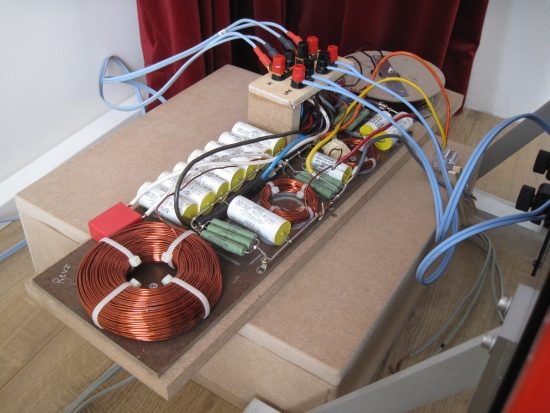
The original Duetta Reference crossover was made to work externally. The square red capacitor on the top left is all that differentiates the Duetta Reference crossover from the Duetta Signature crossover.
Final Crossover Tweak
Since some time (see part 3 of this review), I use original Apogee crossovers with the refurbished Duetta Signatures, but these are Duetta Reference crossovers. The difference with Duetta Signature crossovers is only in the addition of a single capacitor with which the speakers were specially tuned for the German market. I’ve long pondered about its influence, and after speaking with Henk, I was quite sure that it would lift treble output. Now that the speakers had returned from their beauty treatments with their new tightly stretched mesh and brand new KLM5 drivers, it was time to snap out this capacitor and return the crossovers to full standard spec again.
Sure enough, snipping out the extra capacitor restored the treble output to normal. Briefly re-attaching it again just to be sure revealed that indeed it lifted treble output and not by a small margin. With the Duetta Reference crossovers now being identical to Duetta Signature crossovers, the improvements that the KLM5 drivers brought were even clearer. Not only had resolution increased, resulting in more treble air and a more fluid overall presentation, the speakers had lost none of their drive and power, or their dynamic impact. And now that the MRTWs were playing at their intended levels, the transparency and cohesion were also further improved. The speaker now spoke as a whole, more like a single driver if you will.
Perspective – originals vs refurbished
In a way, before the installation of the KLM5 ribbons, the refurbished Duetta Signatures have always reminded me of AvantGarde horn speakers such as the Uno G2 not only in terms of purity and sheer dynamic impact but also for their hugely impressive bass. They may not go as loud as AvantGardes but they still go up to party level easily and have more than enough reserve to handle all audiophile needs. Like the AvantGardes, they can be totally magical, but there is often an overall shouty quality in the midrange, and all of a sudden the speakers can lash out, for example with brash trumpets or loud female vocals.
Conversely, the two original pairs of Duetta Signatures that I owned never sounded anything less than sweet, gentle and airy. This is not surprising, as their ribbons had been in place (and in use) for 20 or so years, and, therefore entirely relaxed, but they were quite certainly not appropriately tensioned anymore. They are restrained in ultimate impact, but dynamically still well-differentiated. Bass, while still incredibly deep, is less punchy and lower midrange less powerful than an up-to-date pair, but musically, the classics always perform well and subjectively I’d say that they are still more dynamic and involving than Magnepan MG3.6R’s.
The Refurbished models with KLM5 MRTW’s, new interfaces, new wired returns and original crossovers combine the best of both worlds. They have all the drive, power and dynamic impact that the initial refurbished set had with their newly built but off-spec crossovers, yet none of their raggedness or uncontrolled MRTW driver behavior. Add to this startling coherence and resolution better than that from the aging originals, and top it off with fluidity and refinement close to the original classics and I think it is clear that we have a winner.
Naturally, in matters audio all is relative, and there will still be advocates of the more mellow and relaxed sound of the original classics, but on balance I personally prefer the more energetic and propulsive sound of the refurbished models and I especially prefer their incredible resolution and transparency now that the KLM-5 drivers have been installed. Taste aside, technically the refurbished models are definitely better. They are incredibly dynamic but also very revealing, so they will need to be married to carefully selected electronics.
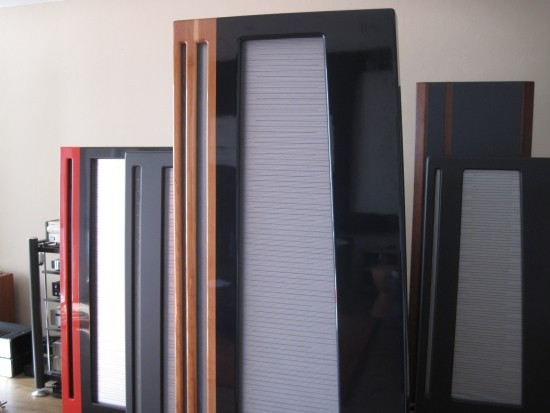
Diva
Compared to my refurbished Divas (that use older Graz drivers installed almost 10 years ago), the Duettas are much more dynamic and have A LOT more propulsion and drive. With the right amount of toe-in, the Divas can image well, but not entirely as good as the Duettas. The Divas, however counter with even more top-to-bottom evenness and less obviously thunderous but deeper bass. Although I have tried many amps by now, I’m still not ruling out the possibility that my Divas are somewhat underpowered by the Rowland sixes, but as it stands now, they are sometimes too polite. Although they are dynamically well differentiated, the Divas are not always hitting the mark regarding slam or punch. The refurbed Duetta Signatures, however, have no such issues. Divas may not be the greatest rock stars, but Duetta Sigs can really rock out.
Amplifiers
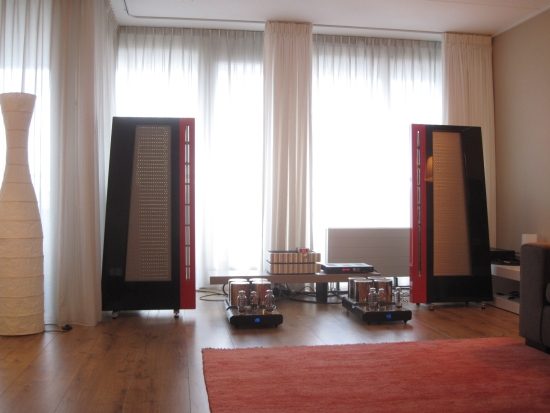
In my expericene, Tube amps normally do not apply, unless they are really potent. SETs such as the otherwise fantastic VAIC Reference 520 above, specifically don’t work well, resulting in a very slow and creamy, thick, covered-up sound. I also tried various other tube amps, but so far they all produced an overly smooth sound with flattened dynamics. Do note that when matched correctly, SETs are definitely capable of very punchy sound. For example, when combined with the Centaurs, in spite of their 50w rating the VAICs have staggering bass heft and extremely impressive dynamics, and this combination really sounds nothing short of magical.
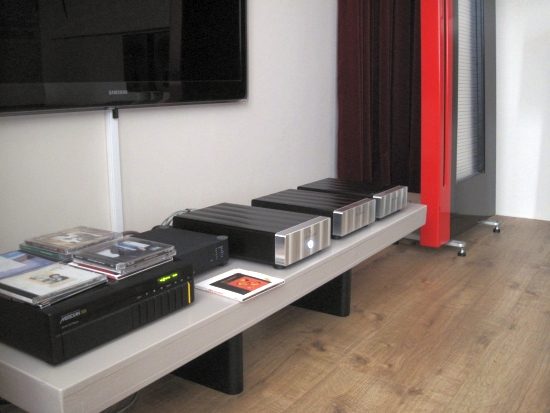
Still, Duettas are not incredibly hard to drive: any amp that outputs healthy current and remains stable at least into 3 ohm loads is theoretically up to the task. I found that the sophisticated yet detailed sound of my classic Jeff Rowland model 6 matches incredibly well, and I assume that a model 2 would also work well. If you want to add some more romanticism then the slightly more recent Model 10 is a very good choice with its fuller, more relaxed sound. Of the more recent amps tried, the more neutral ICE power 201s were also a very good match, as is the 625v2. Also see this model 201, 525, 6 and 10 review for more detailed information.
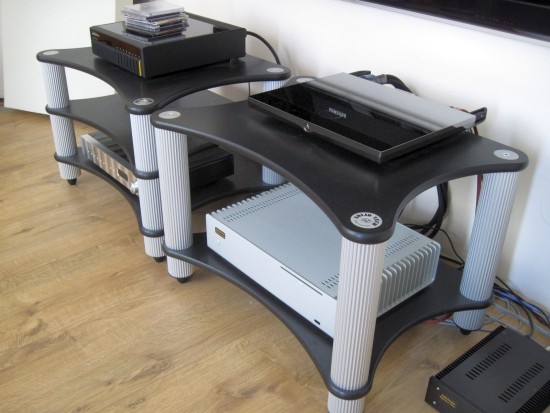
The Devialet 120 worked wonders by sounding both superbly refined as well as powerfully upbeat and the Accuphase E-260 was also excellent, and from what I heard during an Accuphase comparison with other speakers, the creamier-sounding E-600 could well be a match made in heaven.
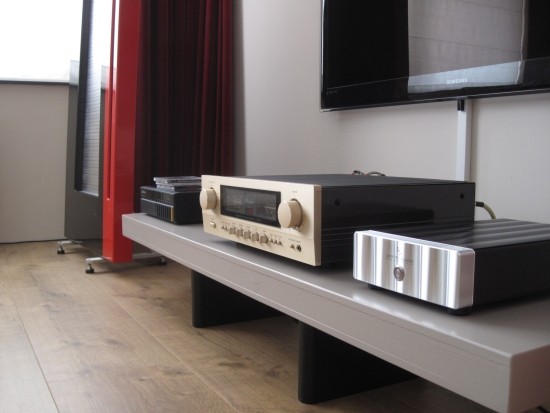
Wrapping it up
The Duetta Signatures are the first full-range Apogees I heard, and I have to confirm that reviewers at the time weren’t wrong: Full Range Apogees really are something special. Most incredible is their bass performance: at once deep, full, dynamic, coherent and fast. All three sets of Duetta Signatures, even the original classics, produce bass in a fashion that makes visitors wonder if the subs are still on, and refurbished Duettas truly have bass that puts many dynamic systems to shame. Apogees are also incredibly dynamic and fast, in a way that makes Magnepan 3.6R’s seem overly well-behaved and sleepy. In spite of not having a cabinet, Apogees don’t sound threadbare at all, on the contrary. Timbre is very lifelike, for example piano really sounding like the wood-and-string percussion instrument that it is.
My previous Magnepan MG3.6R’s by comparison often made piano sound too thin, almost like it is a keyboard and not the real thing. And remember that I’m talking about the Maggies with aid of two REL Strata II subs versus Apogees without subs. The Magnepans sure have tight, articulate bass, but there’s no real drive to speak of. There are advocates for both camps, each accusing the other camp’s speaker of having coloration. Magnepan MG3.6Rs have one advantage over Apogee Duetta Signature though, which is their pure ribbon treble, which is quite simply heavenly, refined and airy. Apogee Duetta Signature treble (being an MRTW with Kapton backing as opposed to pure ribbon) by comparison is just a little less superbly delicate, but still worlds better than the large majority of dynamic tweeters out there.
While it could be argued that perhaps the Maggies sweeten the treble too much and perhaps the original Duetta Signature’s treble performance is simply honest and revealing what’s on the recording, the initial refurbished pair used incorrect crossovers resulting in severely tipped-up midrange and treble. In any event, from memory the new KLM5 ribbons together with the new interfaces and wired returns all but closed the gap.
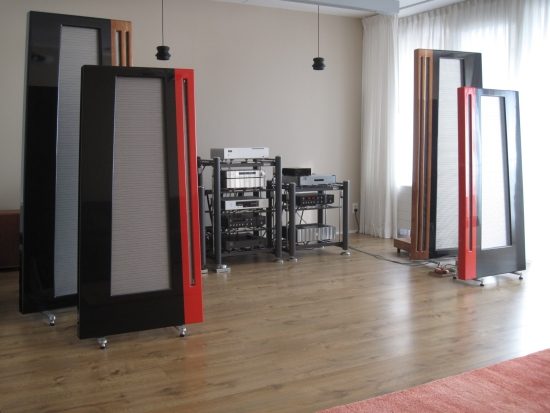
Room friendly
It’s becoming more and more evident that dipoles work better than dynamic speakers in rooms that are otherwise plagued by standing waves, otherwise known as room modes. Without bass traps, both my listening rooms have severe issues, and where dynamic speakers tend to boom and honk and have uneven frequency balance, all the Apogees, as well as the Magnepans, sounded much more even-handed in these untreated rooms, and without exeption delivered much better bass. Contrary to popular belief I would say that Apogees are actually easier to position than dynamic speakers. The only thing they need is some space from the rear wall. 2 meters yields best results but 1 meter is already sufficient.
Finally, cost considerations. Sure I can understand that it doesn’t seem entirely “cheap” to get the full refurbishment done on an existing pair. But think of it another way. A newly refurbished pair with the latest drivers and a new cabinet will cost around 6500 euro. Now just think about the ever-increasing cost of current high end speakers. For 6500 euro not a single speaker comes to mind that would even begin to deliver a performance like the Duetta Signature. At double or triple this amount however some aspects of the sound can be matched, but usually with less overall top to bottom coherence. Marten and Vivid Audio for example are competitors in terms of treble and midrange performance, but you’d have to climb up to one of the dearer models (30-60k) before you approach the incredible bass extension that any Apogee is capable of and even then, with a less than optimal room, the bass drivers may still be more or less leading their own life relative to the rest of the frequency spectrum. In this context, a refurbished Duetta Signature offers insane value for money!
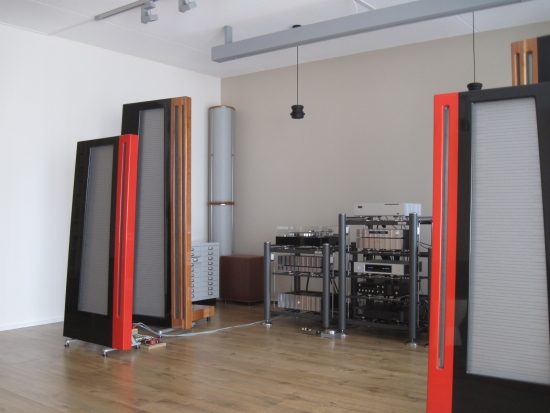
Serial Numbers:
Jan’s original set: 13 998
My (CP) original set: 13 182
JW’s DS red/black refurbished pair: 13 185
Duetta Reference Crossovers: 13 180
Refurbished pair ribbon types for part 4 of this review:
Bass: KLM v2 (2006, KLM construction, v2 pattern)
MRTW: KLM5 (Freshly installed September 2016)
update 13-04-2025
After inheriting a pair of original Duetta Signatures, the Apogee bug bit me again… Not only have I fallen in love with these speakers all over again, but I may even switch back to them as my main speakers. Of course, being originals at 35 years old by now, this Duetta pair urgently needs an overhaul.
Henk van der Hoeven will refurbish them using the latest Graz ribbons, interfaces, and return wire system. Additionally, he will build a new crossover and install metal ribs to stiffen the frames.
After completing this, I will write a new article describing how they sound before and after the refurbishment.
More Duetta Signature
Initial Duetta Signature Review
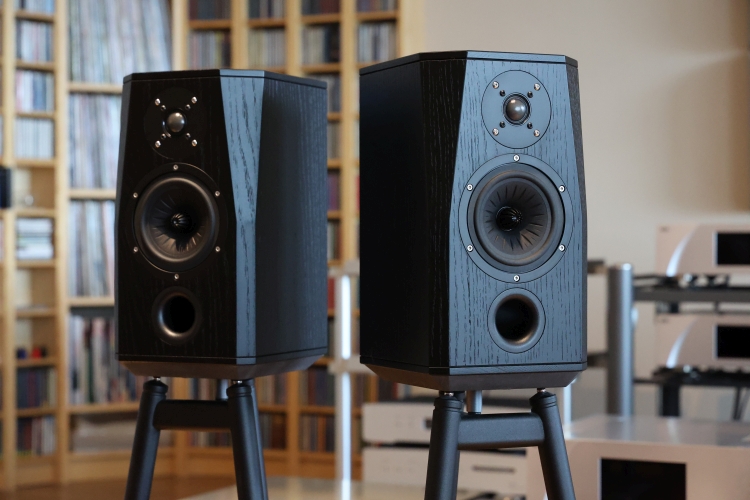
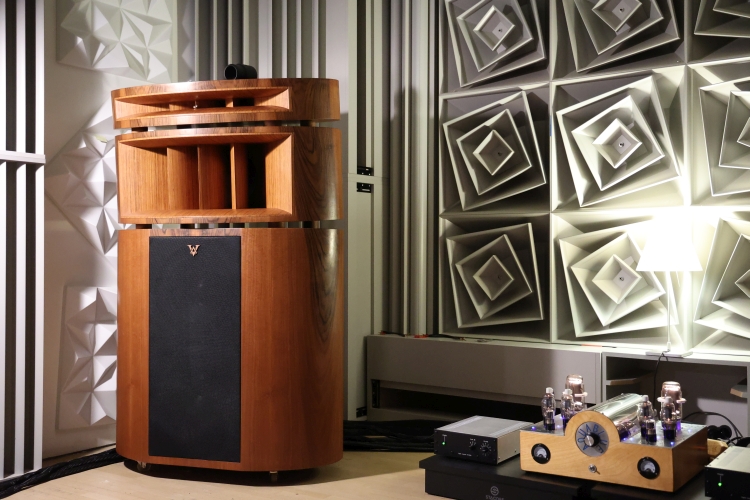
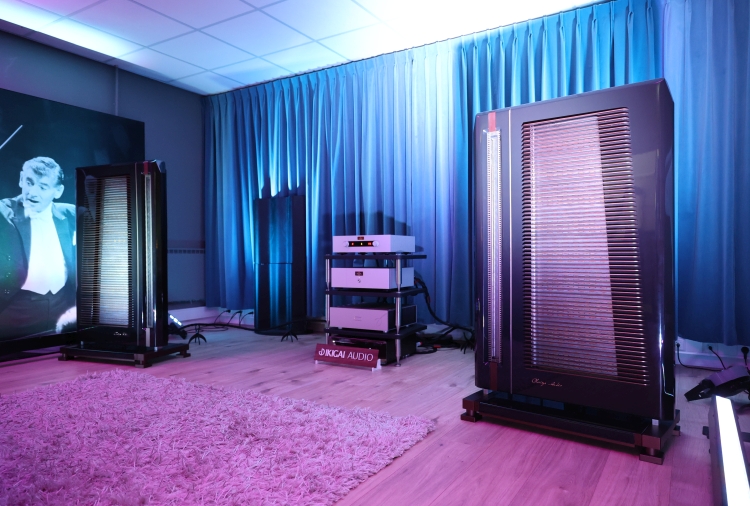
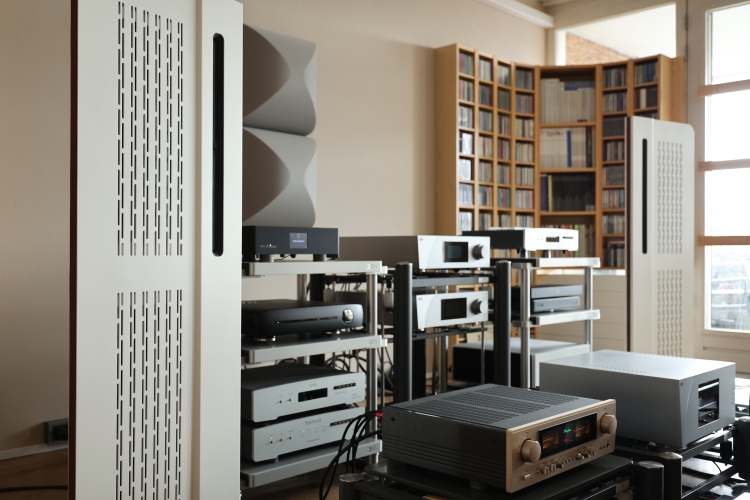
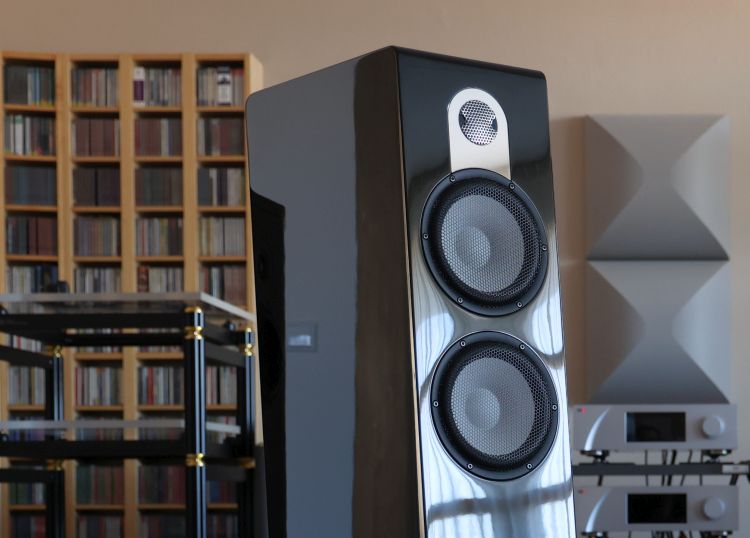
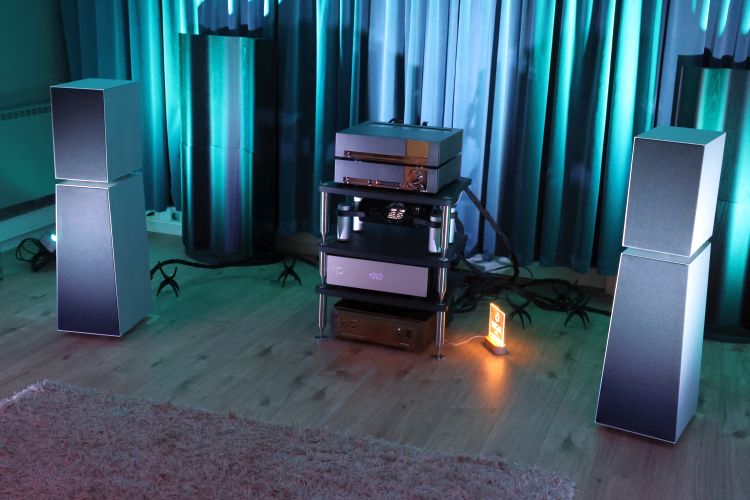
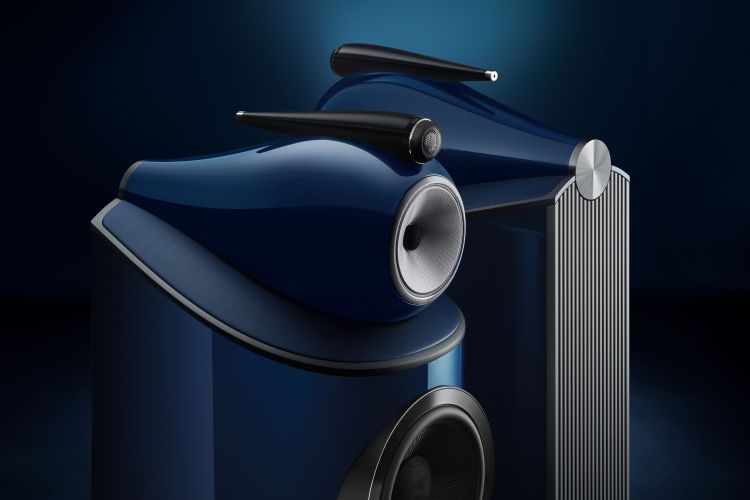
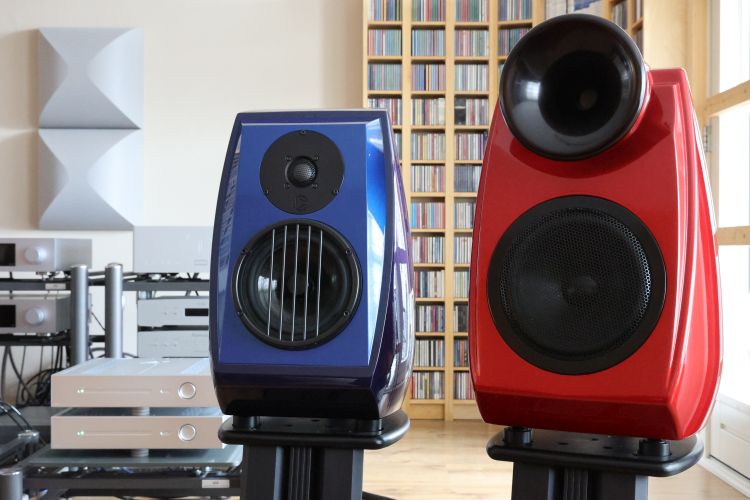
Hi Christiaan,
Do you still have Symo cables LS4X, LS5 SX for sale? If so, what lengths? I have rebuilt Apogee Duetta Signatures that I would like to try them with.
thanks!
Hi Sandip, I still have various lengths of the LS4X but am not selling, as they frequently come in handy during reviews and comparisons. That said, I currently have both Centaurs (not minor or major) and Duetta Sigs set up simultaneously in the second room, both wired with LS4X. The Centaurs match much better with this cable than the refurbed DS, as the LS4X is not the brightest sounding cable, and also not the most refined, a bit coarse even, making the DS sound grubbier than they are. For the Centaurs this is fine and actually works splendidly because the Centaurs have a lot of HF energy and sound quite forward. The DS I feel sound better with a more straightforward cable such as the cheap van den Hul Skyline Hybrid. It’s laughable in a way, but that is the cable that I already use for more than a year with the Divas because it sounds so neutral, open and airy, but also fluid and unforced and without any harshness. Biggest downside of this VDH versus the Symo is that the VDH sounds quite thin while the Symo sounds quite full-bodied. Then again DS have plenty of bass so I would still suggest a brighter sounding cable for them than the Symo. That is, unless you actually want to tame the brightness of your DS, then the Symo might be a solution worth exploring.
As a generic update: I do still have and use Symo cables, but am not selling them.
Yet another great Apogee review from you. I still remember my long gone Duetta Signatures, the best speaker I ever owned. What I would like to read is a review of the Synergy 1.5, a modern Scintilla and perhaps the best planar there is together with the Alsyvox.
Oh yes, the Synergy 1.5 I’d also like to review, and a modern Scintilla even more so. But shipping it across the globe is not a simple task and also quite expensive. Still I’ll check with Graz to see if something is possible here.
As owner of Apogee Duetta, I’m wondering if using passive Bi-amp on Apogee Duetta worth it to get the best sound.
Nowaday, amplifier have more than 130 ampere (i.e Hegel H30 amplifier).
Could you please give be your “hifi-advise” ?
I have found that the Duettas are not particularly power hungry and do not need bi-amping for that reason. 130 amps also is easily enough. However, bi-amping can bring other advantages (soundstage height, clarity, definition) but only as long as two or four identical amps are used. It is easy to mess up coherence between the drivers though and the benefits are not guaranteed, so in conclusion I would not advise bi-amping Duettas. Divas are another matter, as are Full Ranges.
Hi Christiaan,
I have a pair of Apogee Centaur Majors and run them with a monoblock pair of Aronov 110w tube amps.
I bought a set of the new KLM5 treble ribbon replacements from Graz, mainly as a backup as my original ribbons still sound ok.
Would you have an opinion on whether I should just go ahead now and install the KLM5 ribbons? And that by doing this, I might find that they are a real upgrade in sound as compared to the originals? I am a bit worried that the sound might change quite a bit, and the KLM5 might be more detailed but possibly with some extra detail may come a ‘cooler’ sound (I prefer ‘warmer’). Really appreciate any thoughts you can offer! Thanks Mark
Hi Mark, indeed, the sound will change quite a bit. Many, I suspect, will find the difference to be an improvement while some may not feel that way. The new ribbons will sound more articulate and more dynamic and will be overall more impressive. Resolution of detail will appear to have improved as well, although I don’t personally feel that you hear more detail but it’s just presented more directly and cleanly. It’s not really a matter of warm versus cool, though. The originals are not warm either, just more relaxed and less explicit than the new ones. Newer ribbons will also improve the bass overtones which may help solidify the sense of bass and can actually enhance the speaker’s fullness of bass. The improved transient sharpness will also make the sound tighter, purer, and drier than the old ribbons and that will be a matter of opinion. Personally, I’d be hesitant to replace ribbons that are working just fine and would wait until they start misbehaving, unless you are looking to improve the speaker’s dynamics and expressiveness.
Thanks Christiaan,
I really appreciate your comments. I have owned or heard other Apogees, including fullrange Duetta and Duetta Signature, plus the Centaur and Centaur Minors. The Minors in particular sounded wonderfully alive, crisp and detailed on audiophile discs but were not very forgiving at all on lesser recordings. I was relieved to find the Majors longer ribbon does not sound quite as explicit as the smaller hybrids, and therefore I am able to play a much wider variety of music (including not so great recordings).Since I have a relatively live sounding room (even with lots of room treatments) I think perhaps I should stick with the Majors as they are for now and eventually replace them later when they need it. Cheers Mark
Hi Mark, indeed, the mid-range Centaurs and Centaur Minors are incredibly open and direct but in many situations can have a little bit too much treble energy. They need a large room / a lot of distance from the speaker for them to start sounding a little bit forgiving but when they fit, the Centaurs can sound marvelous. The Centaur Majors are much darker and more sonorous and more full range and although new ribbons will make them more articulate and direct, they will certainly not make them sound like the smaller Centaurs. But if you like how they sound now, then why hurry? 🙂
Christiaan,If you want to improve the Duettas to the ultimate may I recommend the modifications I have done to mine.
I replaced the MRT ribbons with the rare XLM2 type which are lighter than the KLM5s.Also I run mine actively with a pair of modified hypex amps.I also stiffened the back of the panels with a pair of full height 30 mm angle iron pieces screwed just inside of the existing feet and then bolted two struts midway up these to the back edge of 45kg damped granite bases the speakers stand on.
With these mods the bass is tighter and also free of wooden floorboard resonances.The active crossover,which I built myself,I found that the best crossover frequency to be 350Hz after a bit of experimenting.Hope this is of interest to you.
Regards,Bob Lewis
Hi Bob, thanks for the suggestions. Although I don’t own any Apogees anymore I’m sure that they may help others out there. By the way, my red/black Duettas also had a stiffened frame twice the depth of a normal frame and I know that using steel bracing can bring further real benefits.
Hi Christhian,
I follow your steps at HFA, congrats for blog.
Your Speakers change was not surprise for me, seem to be that Wilson is on the horizon from most who likes Apogee.
I need a little help with my job to active biamp Duetta S, because passive XO in my Duettas have not wirings ready to connect. When it were rebuilt didn’t thought (who did it) to the future.
Can you help me,
on the passive XO schematics Where the cables I must connect to go to binding post?
I got Bryston active XO and I’d like try.
Thanks again and best for you.
Gerardo
Hi Gerardo, For active bi-amping, after having set the correct relative crossover points on your crossover unit, you can connect the drivers directly to the power amps, bypassing all the Duetta’s passive circuitry, so straight to the final connection points of the Woofer and MRTW which are the right-hand connections in the schematics. Be VERY careful and start with very low levels as sending a full-range signal to the MRTW can over-stretch and damage it.
Thanks Christiaan for reply.
Honestly I was almost certain that the bass panels were connected directly, but my doubts with the MRTW were for the safety of a possible DC current when turning on the treble amplifier. I even assumed that some component made an impedance compensation network.
I would not want to make an insurmountable or costly mistake to save.
Please let me know the safest way to do it.
regards
G
Hi Gerardo, I don’t think there is an impedance matching part in the DS crossover, it may look complex but that’s to allow for the different settings that can be selected with the toggle switch and the crossover by itself is very simple. Yes, Apogee claimed to have applied a slope upon another slope that other engineers claim is impossible but that part has never become entirely clear for me. The speakers will work with any 2-way crossover, be it active or passive but whether or not you will like it better remains to find out. From all my experiments with the Diva crossovers I know that it is very easy to mess up the coherence and extremely hard to get it right.
However, I should note that I am not an engineer. Just an enthusiast audiophile with a pretty good understanding of electronics who happens to have used a lot of Apogees. So please take my advice as a rough guideline and perhaps check in with an Apogee restorer or an actual electrical engineer.
What I know is that capacitors theoretically do not pass DC when applied in series and in that sense, the MRTW is somewhat protected by the passive crossover (as long as you have no balanced amp or connect any wires incorrectly). When crossing over actively, you are not supposed to use any passive circuitry because that would again degrade the performance and negate the upside of going active. The only instance with Apogee that I know this does happen is with the Full Range which is a three way, when driven with a two-way active crossover. In this case there is a capacitor on the treble foil.
It is possible that your active crossover has a series capacitor in its output path or even has active DC cancellation. Capacitors always have a certain character and need to be carefully selected for the desired operation but if you wanted to experiment with this on the speaker end that’s not something I can help you with.
In any event, a short burst of DC (of low to moderate levels) will not immediately hurt the foils meaning that a short surge after switching on should not be problematic. Only when it is applied for longer and with enough current will they start heating up and deform or one of the traces may even burn through, eventually.
Hi Christiaan,
I have been seriously considering to replace my maggie 1.6QR with Duetta Sigs. I feel that the 1.6QR really lack the slam or impact that I’m accustomed to with box speakers but I get the feeling that the Duettas get a it closer while still maintaining the great sound of a planar. A few years ago I acquired my threshold S/500 II, now I have adequate power for some Apogees. Although, probably still not enough for the 1ohm Scintillas which are my dream. I believe you have moved on from the Apogees, but I just wanted to get your opinion or see if you knew anyone in Germany or Netherlands who has a system with Duettas? Thanks!
Indeed, Duetta Signatures will give you MUCH better bass than any Magnepan. You might be surprised to find there’s even a bit too much depending on the setup:-)
I own no Apogees anymore but know people that do. A close friend has original DS that I listen to quite frequently. So, they never fully left me. While Scintilla sure is better than the DS, it mandates careful amplifier mating. Not many amps are comfortable driving those loads.